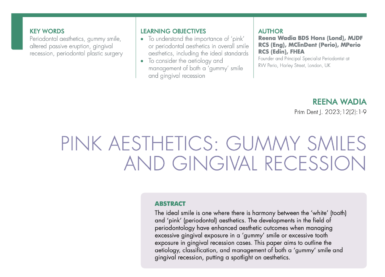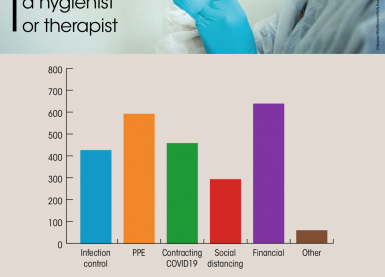Home/Articles
/ Periodontology /
Reena’s Notes: Inflammation – Dr Low Dog, Professor Van Dyke & Professor Lord at the BSP Conference
October 12, 2014
 The Fire Within: Nutrition and Lifestyle Approaches to Treat Chronic Inflammation – Dr Tieraona Low-Dog
The Fire Within: Nutrition and Lifestyle Approaches to Treat Chronic Inflammation – Dr Tieraona Low-Dog
Diet
- One of the primary drivers of inflammation and insulin resistance is high glycemic load carbohydrate.
- The WHO has recommended that people should limit the amount of added sugar in their daily diet to 25 grams, or 6 teaspoons. One soda will already put you 40% over.
- Limit high glycemic load foods by dramatically cutting back on sweets and processed foods.
- Current guidelines recommend limiting sodium to 2300 mg per day; though studies also show we can tolerate higher amounts when the diet is rich in potassium.
- Olive oil is a healthy fat. It also contains oleocanthol, a potent anti-inflammatory.
- Pre and probiotics – regulate/improve immune functions and are beneficial for oral and gastrointestinal health.
- The mouth is a gateway to the GI tract and so the rest of the body. We need to start thinking about supporting a healthy symbiotic microbiome rather than just killing the “bad” bacteria.
- NFκB inhibitors shut down inflammation. There are many natural inhibitors found in green tea, cocoa, parsley and turmeric. Turmeric contains curcumin, a particularly powerful multitargeted anti-inflammatory.
Sleep
- Sleep deprivation – repeated disruptions of the circadian system, can have significant adverse effects on human health by impairming the immune system, inducing metabolic changes favoring obesity and generation of pro-inflammatory reactive oxygen species.
- Meditation can be an important tool for enhancing neuronal activity and resiliency.
- A sharp mind is a disciplined mind; it requires work.
Touch
- Social interactions are extremely powerful. The number one therapy women choose once they have been diagnosed with breast cancer is massage. Never underestimate the power of touch and human connection. All mammals crave closeness as it releases endorphins and enhances our sense of wellbeing.
Nature’s Way of “Putting Out The Fire” – Professor Thomas Van Dyke
- Periodontitis – gram-negative bacterial infection, destruction of tissue mediated by the host, several clinical presentations and pathogenesis similar to other inflammatory diseases.
- Inflammation is the driver for the changes in the composition of the microbiota. Pathogens associated with disease seem to be associated with inflammation. Good bugs express genes and the drivers for how they’re expressed may be more important than plaque. Uncontrolled inflammation is the culprit in disease – when excessive and uncontrolled lead to disease.
- Thoughts on mechanism: rapidly turned on after an acute inflammatory challenge, active cellular events and biochemical pathways, mediated by anti-inflammatory and pro-resolution compounds.
- Injury or infection results in an acute inflammatory response that leads to abscess formation or wound healing with scarring. This is good for host survival. A periodontal abscess actually shows the body successful attempt at limiting the infection. Healing at new set point, not homeostasis. Chronic is the failure of this system.
- Ideal outcome is complete resolution or regeneration back to original homeostasis.
- Periodontitis is still a bacterial disease. However, we are less sure about the specific organisms that initiate the disease.
- Periodontitis pathogenesis is an inflammatory disease. Neutrophil mediated tissue injury plays an important role in establishing the chronic periodontal lesion creating the local environment for overgrowth of pathogenic bacteria.
- In addition to the inflammation activation pathways, there are endogenous inflammation resolution pathways.
- Resolution of inflammation is an active, receptor-mediated program promoting tissue healing and return to homeostasis.
- Pro-resolving lipid mediators – endogenous chemical mediators, agonists, counter-regulate stop signals, promote resolution and are anti-inflammatory. Antimicrobial defense mechanisms and clearance of mucosal surfaces
- Omega 3 fatty acids are protective – reduced thrombosis, reduced hypertension.
- Resolution phase interaction products (resolvins) – a new family of bioactive products of omega 3 fatty acid transformation circuits initiated by aspirin treatment that are anti-inflammatory.
- Inflammation resolution – maresin, protectin, resolvin, lipoxin.
- Immunoresolvents had been shown to have regenerative capacity.
- Animal studies: Rodents are not a good model for periodontitis as the immune response is very different. Rabbits are good. Dogs are okay but they do not chew the ways humans do. Primates are closest phylogenetically but expensive. Pigs are particularly similar – omnivore, chew like us, jaw same size if miniature pigs, naturally get periodontitis but if induce do not heal and the immune system the same.
- Without controlling inflammation, other tools are not useful. For example, Nyman has shown that when using GTR and growth factors, the level of regeneration of bone stops at the level of inflammation. Therefore, the control of inflammation is key.
As Old as Your Cytokines – Professor Janet Lord at the BSP
- Longevity and experience of old age is very variable. Average life expectancy is increasing at 2 years per decade, but healthy life expectancy (health span) is not keeping pace. We are living longer but not healthier lives.
- Longevity and health span can be modified.
- Do immune ageing and inflammation contribute to age related frailty?
- Inflammaging – the increase in systemic inflammation that occurs with age and is known to drive many age-related diseases. Caused by many factors including inactivity leading to obesity, hormonal changes with age, and changes in the immune system. Increasing physical activity, including High-intensity interval training, reduces inflammaging (reduced serum CRP and IL-6).
- Inflammaging and neutrophils – chemotaxis, phagocytosis and bacterial killing all reduced with age. Neutrophils help find and remove infections but can also cause damage along as they release proteases as they migrate which leads to tissue damage and inflammation. The neutrophils of older adults migrate with less accuracy and create up to 5 times more tissue damage in this way, making older adults frail after infections.



